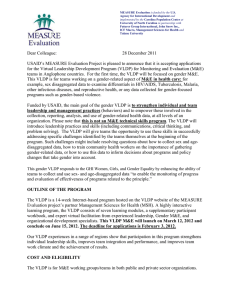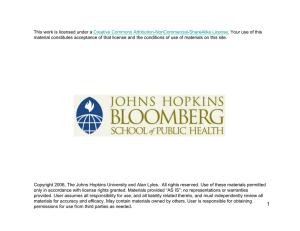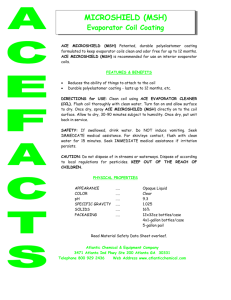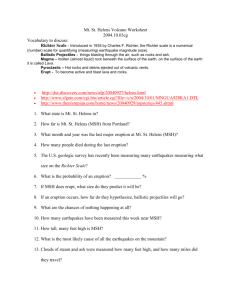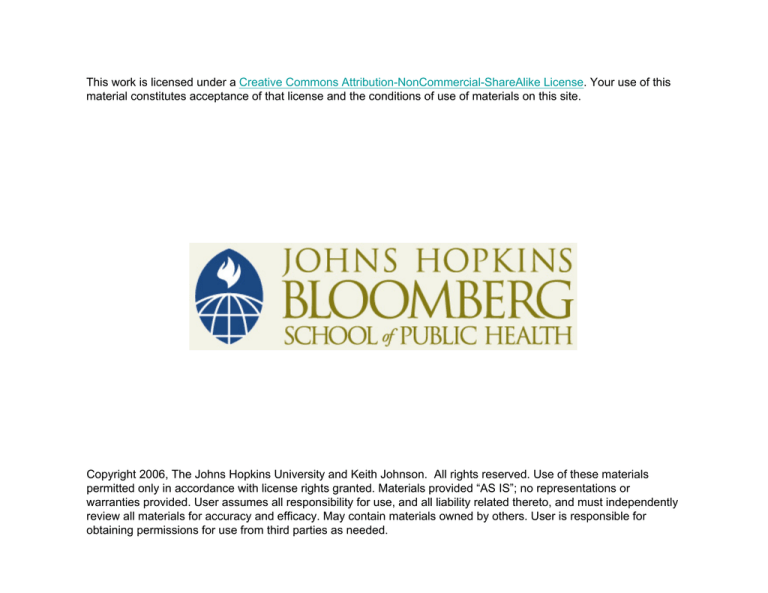
This work is licensed under a Creative Commons Attribution-NonCommercial-ShareAlike License. Your use of this
material constitutes acceptance of that license and the conditions of use of materials on this site.
Copyright 2006, The Johns Hopkins University and Keith Johnson. All rights reserved. Use of these materials
permitted only in accordance with license rights granted. Materials provided “AS IS”; no representations or
warranties provided. User assumes all responsibility for use, and all liability related thereto, and must independently
review all materials for accuracy and efficacy. May contain materials owned by others. User is responsible for
obtaining permissions for use from third parties as needed.
Session 11:
Access to Essential Medicines
Keith Johnson
Management Sciences for Health
2
Unit Objectives
1. Understand the different dimensions of access
2. Explain how to appraise access to essential drugs at the
community level
3. Describe different types of community participation that
affect access
4. Describe how to do a community needs assessment
5. Describe recent innovations to improve access involving
the private sector
6. Expand the main factors influencing cost, use, and
access to pharmaceuticals
3
What Is Access to Medicines?
• Access: “potential”use (freedom or ability to obtain a
medicine)
• Use: “accomplished”access “exercised”(freedom or
ability to utilize obtained medicine)
• Medicinal products or services may be accessible
(available, affordable, etc.) but not necessarily used
4
Framework for Assessing Access to
Medicines
Source: MSH: Management Sciences for Health. Used with permission.
5
Framework for Assessing Access to Medicines
Supply and Demand Factors
Source: MSH: Management Sciences for Health. Used with permission.
6
Framework for Assessing Access to Medicines
Source: MSH: Management Sciences for Health. Used with permission.
7
Availability
• Relationship: Supply vs. demand
• Determinants:
– Inadequate forecasting of needs, procurement
practices, manufacturing capacity
– Demand for alternative products, etc.
• Interventions:
– Essential medicines list
– pooled procurement
8
Availability: Selected Countries
Source: MSH: Management Sciences for Health. Used with permission.
9
Affordability
• Relationship: Price, cost, value vs. user’s income or
ability to pay
• Determinants:
– Lack of product competition
– Unemployment or level of income
• Interventions:
– Generic or therapeutic equivalence policies
– Social insurance, income generation measures
10
Affordability: Ghana, India, Tanzania
Note: For Tanzania – Sulfadoxine + Pyrimethamine
Source: MSH: Management Sciences for Health. Used with permission.
11
Affordability: Cambodia, El Salvador,
Ghana, India
*Child 1–5 years old, co-trimoxazole; **Adult, amoxicilline
Source: MSH: Management Sciences for Health. Used with permission.
12
Geographic Accessibility
• Relationship: Location of supply or services vs. location
of user
• Determinants:
– Insufficient economic incentives to operate retail drug
outlets
• Interventions:
– “Rural drug outlet” program
– “Pharmacy franchise” program
13
Geographic Accessibility: Cambodia
•
35% of the population is
more than 10 km or 2
hours’walk away from
any basic health care
facility
Source: MSH: Management Sciences for Health. Used with permission.
14
Geographic Accessibility: Tanzania
Distance to Health Facility
•
•
14% of the population is more
than 10 km away from public
facility
6% is more than 10 km away
from private drug retailer
Source: MSH: Management Sciences for Health. Used with permission.
15
Acceptability
• Relationship: Characteristics of products and services
vs. user’s attitude toward, perception of, or expectations
of products and services
• Determinants:
– Product appearance (color, container)
– Information (pharmaceutical equivalence, indications,
instructions)
• Interventions:
– Product change
– Information program
– Customer service improvements
16
Acceptability/Satisfaction
Source: MSH: Management Sciences for Health. Used with permission.
17
Product Quality
Unreliable Medicine Quality –3 to 36 % of samples are
substandard; a health hazard
Source: MSH: Management Sciences for Health. Used with permission.
18
Service Quality
18 to 72% of antibiotics are inappropriately recommended
Source: MSH: Management Sciences for Health. Used with permission.
19
Designing and Implementing Interventions
• Intervention should address identified access gaps
• Multifaceted targeting of different barriers is more likely
to succeed than single interventions
• Evaluation of impact is essential
20
Pharmaceutical Management,
Access, and Use of Medicines
Source: MSH: Management Sciences for Health. Used with permission.
21
Available Methods and Indicators
•
•
•
•
•
•
•
•
Indicators for monitoring
national drug policies
Operational package for
monitoring and assessing
the pharmaceutical situation
in countries
Access indicators
Price monitoring
Logistics assessment
indicators
Pharmaceutical supply
systems assessments
Studies of drug use in
health facilities
Studies of drug use in
communities
22
Tanzania
23
Strategies to Improve Access in Tanzania
Gaps
Interventions
Availability, especially in public sector
Approving additional sources of supply
to Medical Stores Department for
public sector
Accessibility –14% more than 10 km of A regulated network of accredited drug
public facility; 6% more than 10 km
dispensing outlets (ADDOs)
of private drug retailer
Quality and affordability of products
and services, especially in the
private sector serving rural areas
A quality assurance strategy to permit
improved screening of drugs
entering and circulating in the
market
24
Where Do Tanzanians Buy Their
Medicines?
• 339 Part I drug outlets
(pharmacies)
• More than 4,000 Part II
drug shops (dukala dawa
baridi [DLDB])
• Population is largely rural;
only 17% have access to
private pharmacies
• DLDB shops more
accessible to population
than all other public or
private drug outlets
25
So Where Do We Target Drug Access
Interventions?
Sutton’s corollary: Go where the people go
• Public sector (rarely over 25% of encounters)
• Mission/faith-based/NGO sector (up to 40% in rural
areas)
• Traditional medicine (high usage in some areas)
• Private commercial sector (40–60% of encounters)
26
Tanzania Drug Shops –Dukala Dawa
Baridi or “Cold” Drug Shops
Most geographically accessible and the first stop for over
60% of population for accessing medicines
Source: MSH: Management Sciences for Health. Used with permission.
27
Tanzania Drug Sellers –The Problem
•
•
•
•
•
•
Unqualified, untrained
staff
Unknown drug quality
Unreliable source of
drugs
High drug prices
Inadequate regulation
Insufficient variety of
legally available drugs
Source: MSH: Management Sciences for Health. Used with
permission.
28
Tanzania Drug Sellers –The Strategy
•
•
•
•
•
Dukala Dawa Muhimu (essential drug shops)
Accredited Drug Dispensing Outlets (ADDOs)
TFDA regulations and standards of practice
Training (both business and dispensing skills)
Incentives (loans, mentoring, expanded list of legally
sold drugs, marketing)
• Regulation and inspection – Local strategy
• Drug supply – Local sources; TFDA approved products
29
Tanzania Drug Sellers –The Results
Accessibility – 156 ADDO shops are open, with 36 applications pending (80
originally targeted); evaluated using the Singida Region as control
Source: MSH: Management Sciences for Health. Used with permission.
30
Product Quality
People in intervention group have a 1 in 50 chance of buying an unapproved
drug, compared to a 1 in 10 chance in control group
Source: MSH: Management Sciences for Health. Used with permission.
31
Service Quality
Fewer ADDO attendants (14%) sold/recommended antibiotics for URTI in
intervention group at endline than during nationwide assessment (39%) or
in control group at endline(25%)
32
Source: MSH: Management Sciences for Health. Used with permission.
Availability
In intervention group, average availability of antimalarials increased from 74 to
90% vs. 60 to 71% in control region
Source: MSH: Management Sciences for Health. Used with permission.
33
Affordability
Average median prices increased slightly from
baseline to endline in both intervention and control
groups
• Prices in Ruvuma are now more in line with national
market prices; tracer item prices same in both regions at
end-line
• Median cost of course of treatment for malaria and URTI
was better in intervention group60% less for malaria
(TSH 200 in Ruvumavs. TSH 500 in Singida)10% less
for URTI (TSH 900 in Ruvumavs. TSH 1000 in Singida)
• Customer base remained stable in intervention group
34
Tanzania Drug Sellers –The Future
• National roll-out
– Government of Tanzania buy-in; funding
– USAID support for 2 initiatives; other donors
• Expanded services (e.g., child health, HIV/AIDS,
malaria)
• Next steps:
– Developing and testing roll-out strategies;
coordination of donors
– Refinement of training, supervisory, and inspection
roll-out strategy and support
– Roll-out sustainability with continuing government and
donor commitment
35
Chemical Sellers Intervention in Ghana
36
Ghana Chemical Sellers –The Strategy
1. CAREshop®chemical sellers franchise
• For-profit franchisor (GSMFEL); business plan
• Conversion/upgrading of selected LCS shops
• 5-week training; ongoing mentoring/supervision
• Pooled procurement and supplier negotiation
• Central marketing/promotion;
• CAREshopline
2. Regulation and supervision
• Pharmacy Council
• Franchisor supervisory visits (monthly)
37
Ghana Chemical Sellers: The Results
Accessibility–263 CAREshops are open (250 originally targeted) with 40 more
shops scheduled to open each quarter; evaluated against Licensed
Chemical Sellers (LCS) in Eastern/Volta Regions and LCS in Western
Region
Source: MSH: Management Sciences for Health. Used with permission.
38
Ghana Chemical Sellers: The Results
• Service quality: Mixed results
– Increased antimalarial dispensing (50 to 62%)
compared with 3% decrease in control; but only 18%
dispensed exactly according to treatment guidelines
– 59% of staff asked about malaria symptoms (50%
baseline; 31 & 27% for controls)
• Availability: Slight decrease in tracer items
• Affordability: Slight increase; median price 3% less than
Eastern/Volta region controls
• Sustainability: Breakeven point now at 600 outlets
39
Ghana Chemical Sellers: The Future
• GSMFEL committed to continued expansion
– 600 outlets (rate of 40 per quarter)
– Government support for roll-out and prioritization for
donors
• Expanded public health services and products
• Next steps
– Limited drug list, pooled procurement, and
tendering/negotiations
– Expanded line of CAREshopproducts
– Control/recover costs of training and supervision
– Investment capital/additional donor support for roll-out
– Regional warehouses and operational facilities
40
Drug Seller Initiatives: The Models
41
Drug Seller Initiatives: The Results
42
Drug Seller Initiatives: Lessons Learned
1. Both accreditation/regulation and franchise models
appear to increase accessibility
A. Country-specific determination
B. Platform for expanded public health services
2. Training and supervision are key components but are
complex and need to be made more economical
3. Harmonized and limited product lists, coupled with good
forecasting and pooled procurement, are essential
4. The regulatory component, both internal and external, is
critical to ensuring appropriate marketplace behavior
A. Complex and requires resource commitment
B. Decentralized regulation shows promise
5. Key stakeholder buy-in and participation are essential
43
Drug Seller Initiatives: Challenges
• Assuring public health focus and working with public
health initiatives
– Child Survival
– Malaria
– TB/HIV
• Managerial and financial sustainability when scaling up
• Ensuring local source of quality products and maximizing
affordability
• Reaching the “poorest of the poor”
44
Access to Essential Medicines
“…25 years ago, less than half the world’s population had regular
access to essential drugs. Today, through a combination of public
and private health systems, nearly two-thirds of the world’s people
are estimated to have access to full and effective treatment with the
medicines they need. In absolute terms, the number of people with
access to essential drugs grew from roughly 2.1 billion in 1977 to
3.8 billion in 1997.”
Source: World Health Organization (WHO). 1998. Revised Drug
Strategy:WHO's Work in Pharmaceuticals and Essential Drugs.
EB/RDS/RC/1. Geneva, Switzerland: WHO.
45
Access Gap –Scaling Up Existing
Prevention & Treatment Would Save 10.5
Million Lives Per Year
Source: World Health Organization.
46
Implementation Gap
Technology & funding are vital –Scale-up is increasingly limited by inadequate
existing public health delivery systems
Commitments follow Board
approvals and represent the full
amount of the Global Fund's liability
for the period of the grant agreement.
For Phase 1, this period is the first
two years of the grant’s lifespan. In
the case of Phase 2 grant
agreements, this generally refers to
years three to five of the grant’s
lifespan, although not all grants are
for a five-year period.
Incremental disbursements of the
approved grant are made
periodically, not all at once, and so
they lag somewhat behind
commitments. As new rounds are
approved and new grant agreements
are signed, commitment and
disbursement figures rise
accordingly.
Source: Monthly Progress Update – 27 July 2006. The Global Fund to Fight AIDS, Tuberculosis, and Malaria. Used with permission.
47
Summary
• Access is a construct that encompasses various distinct
dimensions
• The proposed analytical framework is useful to measure
the various dimensions, identify determinants, and
design interventions to improve access
• Experience with the use of proposed indicators is
increasing
• We’ve got a long way to go to achieve universal access
and equity
48

